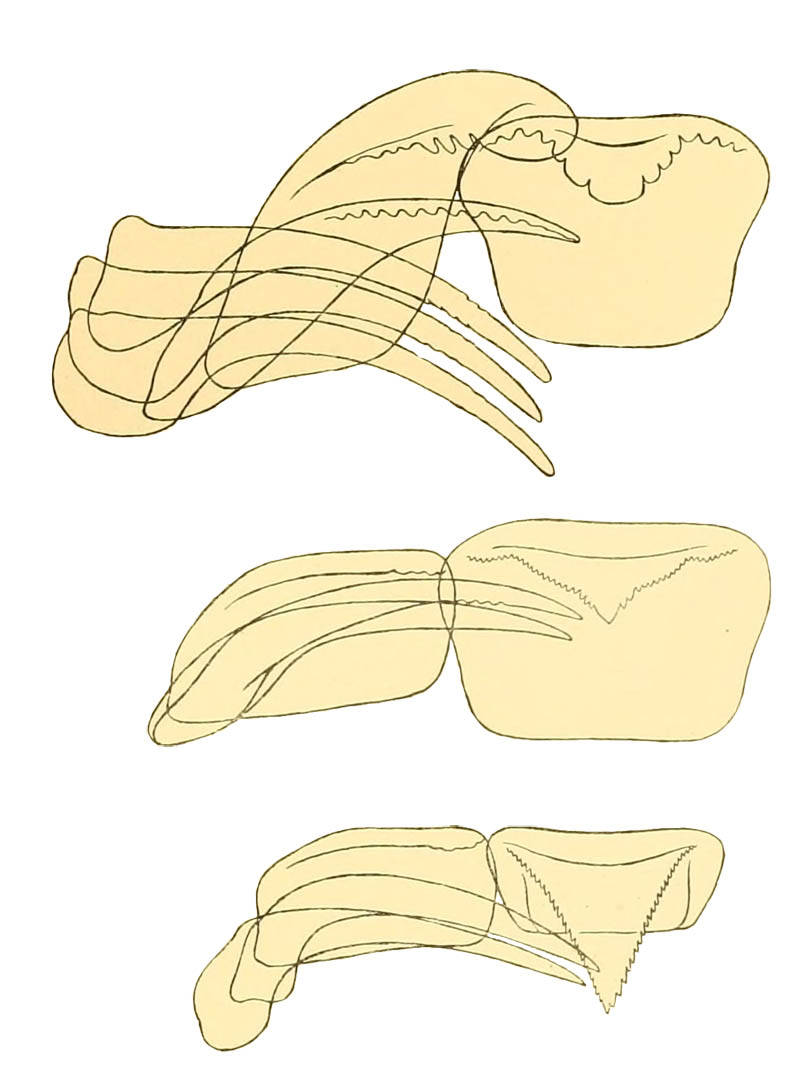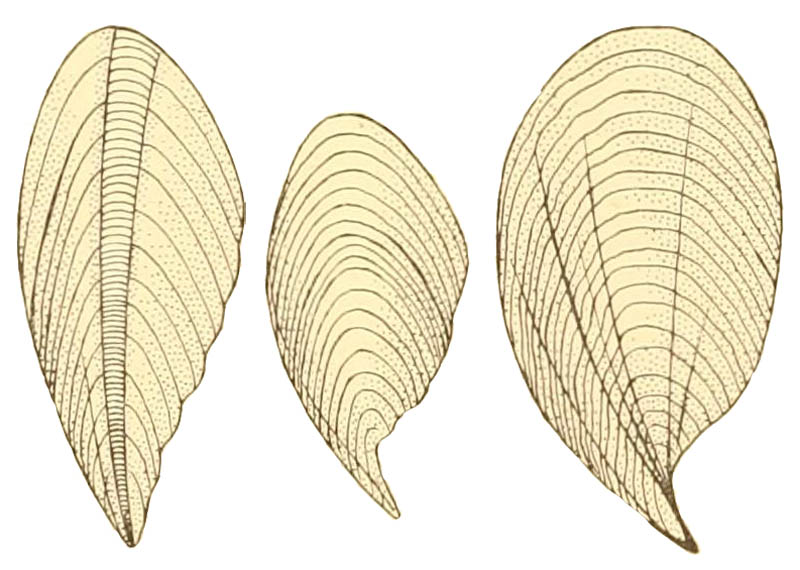|
edit SideBar
|
Species / Struthiolariidae
Stromboidea
- Struthiolariidae Gabb, 1868
Original Description of Struthiolariidae (as Struthiolariinae) by Gabb, 1868:
- "Animal with outer mantel-margin simple; shell oblong-oval or turrited, lips entire."
The following genera belong to Struthiolariidae:
might belong to Struthiolarridae
The following genus is treated as synonym:
History and Synonymy
1951
Powell, 1951, p. 128:
- "Members of the Struthiolariidae are restricted to southern lands, and their distribution can be accounted for only by an assumed former closer unity of these lands, either in the shape of the early Gondwanaland Continent of geologists, or by an enlarged Antarctica with northern radial extensions. The family was already well developed in the Upper Cretaceous of both Patagonia and New Zealand in the form of the gerontic genus Conchothyra, which shows relationship with the more widely distributed Aporrhaidae. In the Tertiary the Struthiolariidae were represented in Patagonia by Struthiolarella (which seems to equal the Recent Perissodonta), in New Zealand by a series of genera, Monalaria, Struthiolaria, Callusaria and Pelicaria, and in southern Australia by Tylospira. The distribution of living members of the family is as follows: South Georgia (Perissodonta, one species), Kerguelen Island (Perissodonta, one species), New Zealand (Struthiolaria and Pelicaria, one species and a subspecies of each) and south-eastern Australia (Tylospira, one species). Marwick (1924), in his excellent monograph of the Struthiolariidae, referred the Kerguelen species to Struthiolarella and omitted reference to Marten's Perissodonta. This genus was again overlooked by Finlay & Marwick (1937, p. 15), when a further valuable contribution was made to the phylogeny of the family. In the light of the adult characteristics of Perissodonta, revealed below for the first time by the production of South Georgian examples with a fully grown, deeply sinused peristome, it seems certain that the South American Oligocene? ornata (Sowerby) is identical with the recent P. georgiana. Both species are presumed to be close to their respective genotypes. Unfortunately, there are no well-preserved apices in the several South Georgian examples, but opercular and radular characters were noted. The operculum in P. georgiana is elongated leaf-shaped with an attenuated terminal nucleus and a median sharply defined sulcus. In both Struthiolaria papulosa and Pelicaria vermis the operculum is shaped like a reversed comma, for it is oval, but with a narrow hooked terminal nucleus. In papulosa there are several radial planes, but these are ill defined (exaggerated in the text figure) compared with the deep sulcus in georgiana. In vermis there are no radial planes, just a slight strengthening rib along the lower inner margin (Fig. N, 120, 121, p. 196). I have not seen the operculum of Perissodonta mirabilis, but Smith's figure (1877, pl. fig. 3a) shows a prominent hook, but this may have been due to warping of the operculum in drying and the breaking away of the lower outer margin. However, a significant similarity to the georgiaiia operculum is the median sulcus which is clearly shown in Smith's figure. Some interesting points arise from study of the dentition of three of the Recent genera: Struthiolaria, Pelicaria and Perissodonta (Fig. I, 35-37, p. 191). First, Struthiolaria and Pelicaria, as one would expect, show closer alliance to each other than either do to Perissodonta, which stands apart by the duplication of its marginals to four or five teeth and the erect, narrowly triangular shape of the laterals as opposed to the rectangular outline of these teeth in both Struthiolaria and Pelicaria. The triangular-shaped lateral of Perissodonta approaches that of Aporrhais, and this feature, coupled with that of the deep labial sinus, makes the derivation of the Struthiolariidae from the Aporrhaidae a very reasonable assumption. Duplication of marginals is evidently an archaic stable feature of Perissodonta, for it occurs in the four examples of georgiana studied, one of which was prepared by Mr John Morton of Auckland University College, who first drew my attention to this fact. Fischer (1884, Text-fig. 442) gives a curious rendering of the radula of the Kerguelen P. mirabilis (as Struthiolaria costulata Martens), in which the laterals and marginals are drawn in an unnaturally erect position, but the essential points, five pairs of marginals and tall narrow laterals, are shown. In Perissodonta georgiana all the teeth are denticulate to some degree. The central has blunt, irregular denticles that vary greatly even from tooth to tooth in the same radula. The lateral has a broadly rounded terminal cusp followed by a series of denticles, the innermost marginal is intermediate between the lateral and the slender marginals and bears ten to twelve small but regular denticles, while the outer marginals have only weak serrations towards their blunt, narrowly rounded extremities. Although both Struthiolaria and Pelicaria have normal taenioglossid paired marginals and almost identical rectangular laterals, the central tooth is distinctive for each genus. That of Struthiolaria is square-based with a multiserrate, broadly triangular cutting edge that does not extend to half the depth of the base. That of Pelicaria is oblong, more broad than deep, but has a very large narrowly triangular serrated cusp that extends far below the base. In Pelicaria both marginals are plain, but in Struthiolaria the inner one is weakly denticulate on its lower inner margin. Unfortunately, the dentition of Tylospira is not known."
 Dentition Struthiolariidae by Powell, 1951, fig. I (from top to bottom)
- 35 Perissodonta georgiana Strebel, South Georgia, St. WS 62.
- 36 Struthiolaria papulosa (Martyn), New Zealand.
- 37 Pelicaria vermis (Martyn), New Zealand.
Opercula Struthiolariidae by Powell, 1951, fig. N (from left to right)
- 120 Perissodonta georgiana Strebel, South Georgia, St. WS 62.
- 121 Pelicaria vermis (Martyn), New Zealand.
- 122 Struthiolaria papulosa (Martyn), New Zealand.
2009
Comment Beu, 2009:
- (p. 201) "The one living Antarctic remnant of the Aporrhaidae/Struthiolariidae clade is Perissodonta which, ironically, seems likely to have been the Late Cretaceous–early Cenozoic ancestor of the entire struthiolariid radiation."
- (p.219) "In my opinion, Struthiolarella and Antarctodarwinella are subjective synonyms of Perissodonta."
References:
- Nielsen, 2005
- H. J. Finlay and J. Marwick (1937). The Wangaloan and Associated Molluscan Faunas of Kaitangata-Green Island Subdivision. New Zealand Geological Survey Palaeontological Bulletin 15: 1-140, Pl.I-XVIII.
- Marwick, 1924
- J. E. Morton (1951). The Ecology and Digestive System of the Struthiolariidae (Gastropoda). The Quarterly Journal of Microscopical Science 92(part 1): 1-25.
- Marwick, (1952). SINGLETONARIA, A NEW GENUS OF THE STRUTHIOLARIIDAE FROM THE AUSTRALIAN PLIOCENE
J. Mollus. Stud.; 29: 83-85
- Powell, A.W.B. 1951. Antarctic and Subantarctic Mollusca: Pelecypoda and Gastropoda; - Discovery Reports 26: 47-196, Fulltext
- J. D. Stilwell (2002). Early evolutionary history of Monalaria (Mollusca: Gastropoda: Struthiolariidae) from the Palaeogene of New Zealand. Alcheringa 25. 395-405.
"Living species of Struthiolaria (S. papulosa, S. vermis and S. scutulata, which differs from Struthiolaria ss only in the terminal varix's inductura being produced for an entire whorl) inhabit clean sandy environments in shallow (c2-20m) of water. They crawl freely on the sand, leaving a prominent broad trail (personal obs, 2m water, S. papulosa) and burrow very shallowly. They live in a sandy crypt with 2 obvious openings, both produced by the proboscis, and (I think) filterfeed from within. I have found only 2 live S. vermis, both in very sheltered water at 3m depth, on the sand surface. S. papulosa inhabits oceanic sands." Cited after Grebneff, 2003
|


